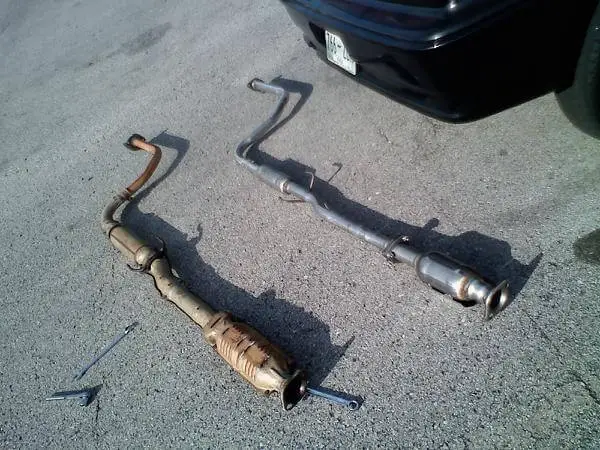
Table of Contents
Catalytic converters are essential technology that helps reduce pollutants in the air such as nitrogen oxide, carbon monoxide, and hydrocarbons.
These contaminants are fed into the catalytic converter and released as carbon dioxide and water vapor via the exhaust. Should You Delete Your CAT Converter
What is a Catalytic Converter?
A catalytic converter is made from a honeycomb beam substrate that includes precious rare metals such as platinum, rhodium, and palladium.
What is a Catalytic Converter
Under what circumstances can one perform a CAT Converter Delete or CAT Delete?
There are no circumstances which permit the removal/delete of a catalytic converter and installation of a replacement converter pipe by any person. If someone is to go against the 1990 Clean Air Act Amendments, they would be violating section 203 (a) (3)(A) and (B) of the Clean Air Act.
State law in 45 out of the 50 United States have statutes or regulations which do not permit tampering of pollution control devices on vehicles. As a result, vehicle owners who tamper with the CAT converter can be subject to significant penalties under federal and State law.
What about off-road use? Is it permitted?
Off-road use is not a valid claim because while you may be ‘driving’ the vehicle only on off-road routes, the motor car or truck is still defined as a:
‘self-propelled vehicle designed for transporting persons or property on a street or highway’ under section 216 (2).
CAT Converter Delete EPA Compliance
Manufacturer-installed original equipment catalytic converters have been custom designed to outfit and perform correctly on a vehicle while lasting its whole lifetime - if the vehicle is maintained and tuned accordingly. However, the unfortunate reality is that all drivers do not conduct proper maintenance required to make their converters last a lifetime. Due to this, many converters have failed altogether or been removed from the vehicle.
Under Section 203 (a) (3) of the Clean Air Act, those people and companies involved in the business of repairing, leasing, selling, servicing, or trading motor vehicles have been prohibited from installing or selling aftermarket catalytic converters, whom have failed to meet the criteria detailed in EPA’s Sale and Use of Aftermarket Catalytic Converters. This is an interim enforcement policy published in August 1986. Anyone that violates this policy is subject to fines up to $10,000 for each improper installation and failing to keep proper documentation/records may also lead to a penalty of this paramount.
Certification labels
Certification labels on the catalytic converters have a series of letters and numbers that appear in the following format:
N/XX/YYYY/ZZZZ
- N indicates the condition of the converter which in this case stands for ‘NEW.’
- XX is the code designated to the manufacturer by the EPA
- YYYY Is a numerical code assigned to the part or vehicle on which it should be installed on
- ZZZZ Is the numerical value of the month and year of manufacture
If there is a ‘CA’ in place of the ‘N’ that means its compliant with California Air Research Board regulations and since CARB is stricter than the EPA, these automatically qualify as EPA compliant.
Furthermore, salvage and junkyards may be held liable for tampering if they sell converters that do not meet the EPA’s policy given.
Legal Fines for CAT Converter Delete
Converter installers and others subject to Section 203 (a) (3) must be vigilant of the legal fines for failing to comply with the EPA’s aftermarket converter policy. They must also comprehend the rationale behind the penalties. The logic is that it is illegal to install the wrong type of catalytic converter in a vehicle because doing so will increase the amount of pollution exiting from the car.
Fines and penalties for incorrect installation include $2500 per violation and up to $10,000 per violation for new car dealers. Individuals may also be subject to these penalties if they conduct or cause a breach.
Did you know: On June 1, 2013, the State of New York adopted the California Air Research Board regulations and mandated that all catalytic converters meet the CARB regulations. CARB is far stricter than the federal EPA, and failure to comply with the requirements can result in a minimum fine of $500 up to $26,000.
How to Avoid the Catalytic Converter Delete
CAT deleting is a practice you should avoid at all costs. Because a vehicle is an intricate system of tuning and computing technology, removing one essential component can have a domino-like disastrous effect on your vehicle.
How to Avoid the Catalytic Converter Delete
Instead of CAT delete, proper maintenance is essential. While smart drivers ensure their vehicles are properly tuned and adhere to using a catalytic converter cleaner every few months, their counterparts may ruin their converters, void their warranties, and possibly cause engine damage along with higher emissions.
If your existing catalytic converter has been ruined and you need a replacement aftermarket converter, you must adhere to the EPA policy and ensure that competent installation has been performed. It is a common consensus that aftermarket converters are not designed to perform as well as the converters initially installed on the vehicle by the manufacturer. However, new aftermarket converts are generally intended to be mounted on a wide range of vehicles. Therefore, backpressure and heat changes may affect the performance of the vehicle adversely.
Here are some tips to prevent a CAT converter delete and maintain your current converter:
- Ensure that you retrieve all power train control module error codes and make the necessary repairs before installing a new converter
- Ensure that the old converter is not damaged by a coolant leak, oil contamination, low compression, by testing base engine condition via a relative compression test, power balance test, and cooling system leak down test.
- Test both oxygen sensors for proper operation and ensure that the fuel trims are in the correct fuel control setting. Standard fuel trims are in the – 10 to + 10-degree area.
- Make sure that the engine’s combustion chambers and fuel injectors are not deposited with carbon. Clean the deposits with a cleaning system if required.
The most common causes of converter failure are that the engine is running too hot, engine oil enters the exhaust, impact under a vehicle that crushes the converter’s physical body, incomplete combustion of by-products, and exhaust temperatures are too high.
Conclusion
In conclusion, the catalytic converter is a very durable device, and the original manufacturer designed it to last the duration of the vehicle’s life without the need for an aftermarket replacement. Now there may be many Youtube videos that appear to tempt you to delete/remove the CAT converter on your vehicle. However, do not follow them, follow our advice and DO NOT CAT CONVERTER DELETE!
 by
by